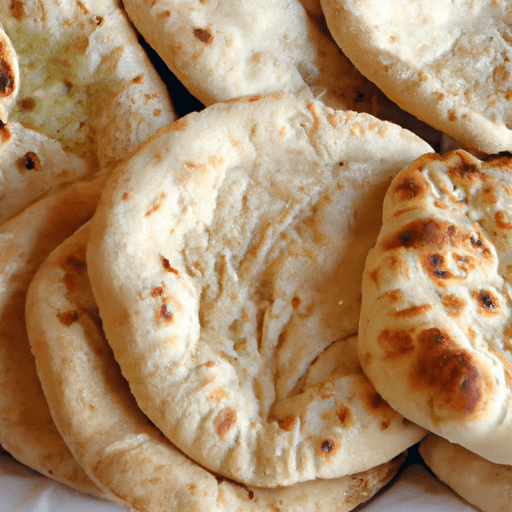The Fluffy and Delicious World of Naan Bread
Naan bread is a versatile and mouthwatering Indian flatbread that has gained popularity across the globe. Known for its soft and fluffy texture, naan bread is a beloved staple in Indian cuisine. In this blog post, we will embark on a journey to explore the enticing taste, culinary uses, nutritional value, and fascinating history of naan bread.
A Taste of India
Naan bread captivates our taste buds with its irresistible flavors. Traditionally made with a combination of all-purpose flour, yeast, yogurt, and ghee, this unleavened bread is cooked in a tandoor, a traditional clay oven. The intense heat of the tandoor imparts a smoky and slightly charred flavor to the bread, enhancing its overall taste. Naan bread has a subtle sweetness that pairs perfectly with the richness of ghee, making it an excellent accompaniment to a wide range of Indian dishes. Its light and airy texture provide a satisfying contrast to the bold and vibrant flavors found in Indian cuisine.
Versatility at its Finest
Naan bread is not just a delicious delight on its own; it also serves as a versatile canvas for various culinary creations. While it is commonly enjoyed as a side dish or used to scoop up curries, naan bread’s potential stretches beyond traditional Indian cuisine. Its versatility makes it an excellent choice for wraps, sandwiches, and even pizzas. The soft texture of naan bread makes it ideal for holding a multitude of flavorful fillings, transforming it into a satisfying meal on its own.
Nutritional Value to Savor
When it comes to nutritional value, naan bread offers a moderate balance. It provides a decent amount of carbohydrates and dietary fiber, which contribute to sustained energy levels. Additionally, it contains small amounts of proteins, fats, and essential vitamins and minerals. However, it is important to note that the specific nutritional content can vary depending on the ingredients used and the cooking method. As with any food, moderation is key.
A Journey Through History
The origins of naan bread can be traced back to the 16th century, where it was first prepared in the royal courts of the Mughal Empire in South Asia. Over time, naan bread became a staple in Indian cuisine, loved by people of all walks of life. Originally, naan bread was cooked in clay ovens until it puffed up and developed a slight char. Today, the traditional method is replicated in modern ovens, allowing people worldwide to savor the delights of this ancient bread.
Interesting Facts About Naan
Here are a few intriguing facts about naan bread:
- Naan bread is believed to have originated in Persia and was brought to India by Persian traders.
- The word “naan” is derived from the Persian word “non,” meaning bread.
- In Indian culture, tearing naan bread symbolizes sharing and represents unity.
- Naan bread is sometimes stuffed with a variety of ingredients, including cheese, garlic, potatoes, and even minced meat.
Conclusion
Get ready to embark on a culinary adventure with naan bread. With its delightful taste, versatility in cooking, and fascinating history, naan bread has become a global favorite. Whether you enjoy it as a side dish or use it as a creative ingredient, naan bread is sure to impress your taste buds. So, the next time you’re craving a fluffy and irresistible delight, don’t forget to reach for the naan bread!
Origin: Naan bread originated in the Indian subcontinent and is a popular staple in many South Asian cuisines. It is believed to have been introduced during the 16th century by the Mughal Empire.
Common Uses: Naan bread is commonly enjoyed as an accompaniment to curries, stews, and grilled meat dishes. It is also used as a wrap for kebabs and other fillings, and can be served as a base for pizza-like dishes.
Nutritional Benefits: Naan bread is primarily made from wheat flour, which provides carbohydrates, protein, and dietary fiber. It is also typically brushed with ghee (clarified butter), which adds flavor and a small amount of fat. Naan can be a source of various vitamins and minerals depending on its ingredients, such as iron, calcium, and B vitamins.
Unique Properties: Naan bread is known for its soft and fluffy texture. Traditionally, it is cooked in a tandoor, a clay oven, which gives it a distinctive charred and slightly smoky flavor. Naan can come in different variations, including plain, garlic, cheese, or stuffed with various fillings like onions, potatoes, or paneer (Indian cheese).
Historical Significance: Naan bread has a long history and cultural significance in the Indian subcontinent. Its association with the Mughal Empire indicates its popularity and influence on Indian cuisine. Naan has also been adapted and popularized in many other parts of the world, making it a globally recognized bread.




Use the share button below if you liked it.
It makes me smile, when I see it.